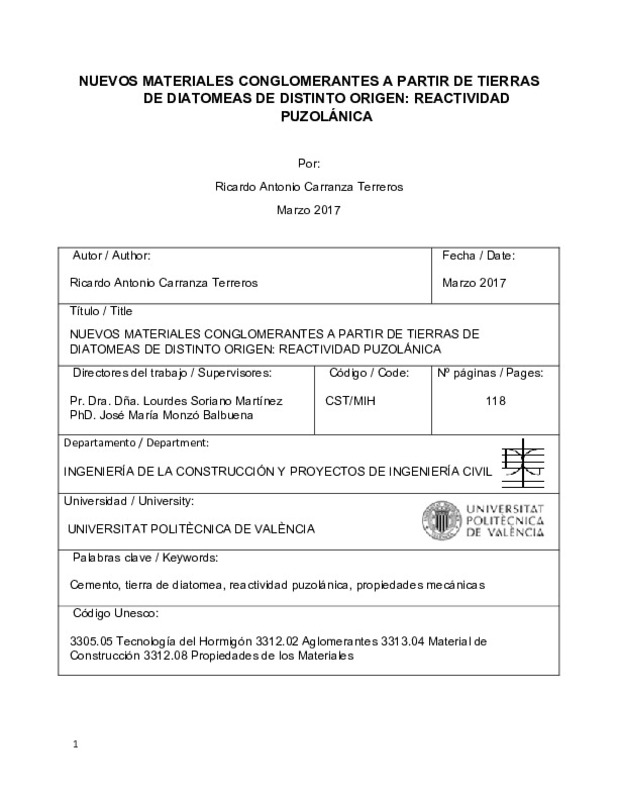JavaScript is disabled for your browser. Some features of this site may not work without it.
Buscar en RiuNet
Listar
Mi cuenta
Estadísticas
Ayuda RiuNet
Admin. UPV
Nuevos materiales conglomerantes a partir de tierras diatomeas de distinto origen: reactividad puzolanica
Mostrar el registro sencillo del ítem
Ficheros en el ítem
| dc.contributor.advisor | Monzó Balbuena, José Mª
|
es_ES |
| dc.contributor.advisor | Soriano Martínez, Lourdes
|
es_ES |
| dc.contributor.author | Carranza Terreros, Ricardo Antonio
|
es_ES |
| dc.date.accessioned | 2017-06-27T09:56:02Z | |
| dc.date.available | 2017-06-27T09:56:02Z | |
| dc.date.created | 2017-03-21 | |
| dc.date.issued | 2017-06-27 | es_ES |
| dc.identifier.uri | http://hdl.handle.net/10251/83725 | |
| dc.description.abstract | In the world, cement is an essential product that covers a variety of needs in a society. The production of cement represents the sector that, at a global level, generates the most amount of greenhouse gas emissions (approximately 5%) Nowadays, it has been identified that the reduction in the consumption of natural resources and the improvement in the usage of wastes as raw materials in various industrial processes contributes to a sustainable development and benefits the environment. Between the potential alternatives that exists right now to reduce the Portland cement greenhouse gas emissions, is the usage of pozzolans as partial replacement of cement. The main purpose of this investigation is to determine the performance of three different types of diatomaceous earth pozzolans as replacements of Portland cement in the proportions of 10% and 25%. | es_ES |
| dc.description.abstract | En el mundo, el cemento, es un producto esencial que cubre varias demandas de la sociedad. La producción de cemento representa el sector a nivel mundial que genera mayor cantidad de emisiones de gases de efecto invernadero (5% aproximadamente). En la actualidad se ha identificado que la reducción en el consumo de los recursos naturales y el mejoramiento en el uso de residuos como materia prima en varios procesos industriales contribuye al desarrollo sostenible y beneficia al medio ambiente. Entre las alternativas potenciales que existen actualmente para reducir las emisiones de gases de efecto invernadero del cemento portland, está la utilización de puzolanas como sustituto del cemento. El principal propósito de esta investigación es determinar el comportamiento de tres diferentes tipos de una puzolana llamada tierra diatomea como sustituto del cemento Portland a valores de sustituciones del 10% y 25%. | es_ES |
| dc.language | Español | es_ES |
| dc.publisher | Universitat Politècnica de València | es_ES |
| dc.rights | Reserva de todos los derechos | es_ES |
| dc.subject | Sostenibilidad | es_ES |
| dc.subject | Puzolana | es_ES |
| dc.subject | Sostenibility | es_ES |
| dc.subject | Pozzolan | es_ES |
| dc.subject | Diatomaceous earth | es_ES |
| dc.subject | Tierra diatomea | es_ES |
| dc.subject.classification | INGENIERIA DE LA CONSTRUCCION | es_ES |
| dc.subject.other | Máster Universitario en Ingeniería del Hormigón-Màster Universitari en Enginyeria del Formigó | es_ES |
| dc.title | Nuevos materiales conglomerantes a partir de tierras diatomeas de distinto origen: reactividad puzolanica | es_ES |
| dc.type | Tesis de máster | es_ES |
| dc.rights.accessRights | Abierto | es_ES |
| dc.contributor.affiliation | Universitat Politècnica de València. Departamento de Ingeniería de la Construcción y de Proyectos de Ingeniería Civil - Departament d'Enginyeria de la Construcció i de Projectes d'Enginyeria Civil | es_ES |
| dc.description.bibliographicCitation | Carranza Terreros, RA. (2017). Nuevos materiales conglomerantes a partir de tierras diatomeas de distinto origen: reactividad puzolanica. http://hdl.handle.net/10251/83725 | es_ES |
| dc.description.accrualMethod | TFGM | es_ES |
| dc.relation.pasarela | TFGM\64512 | es_ES |






